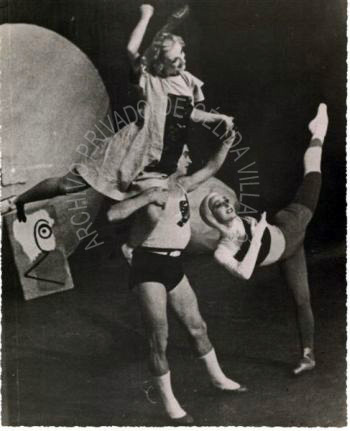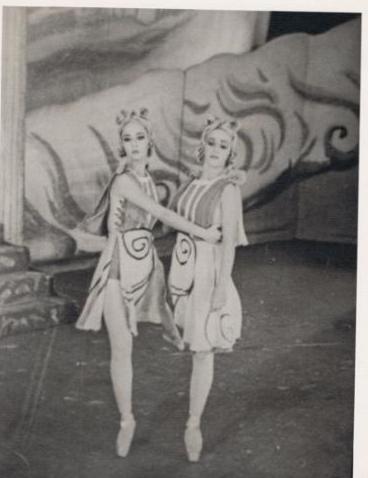THE “OTHER” BALLET RUSSES. LET’S NOT FORGET
The recent success of the fascinating documentary “Ballets Russes”, recalling the history (and substantial pieces of gossip) of the phenomenal company that was known as Ballet Russe de Montecarlo, has awaken an enormous interest in the ensembles known by this name (there were actually two) that sprung after the death of the Russian impresario Serge Diaghilev, in 1929.
By Célida P. Villalón, translation by Vivian Villalón, (U.S.A) 2008 Danza Ballet® .
Twenty years earlier, the impresario had launched the magical adventure that was to become Ballets Russes de Diaghilev, before the mesmerized Parisian theatergoers.
The recent success of the fascinating documentary “Ballets Russes”, recalling the history (and substantial pieces of gossip) of the phenomenal company that was known as Ballet Russe de Montecarlo, has awaken an enormous interest in the ensembles known by this name (there were actually two) that sprung after the death of the Russian impresario Serge Diaghilev, in 1929. Twenty years earlier, the impresario had launched the magical adventure that was to become Ballets Russes de Diaghilev, before the mesmerized Parisian theatergoers. Unfortunately, little is mentioned in said documentary of the “other” Ballet Russe, the one that would arise from the division of the first, founded in 1932, three years after the death of the great Russian promoter.
One of the companies would keep the full name, and would be initially directed by Rene Blum, while the other, under the aegis of Colonel W. DeBasil, would be named, intermittently, Ballet Russe de DeBasil, Convent Garden Ballets Russes, or Original Ballet Russe. Under this last title it arrived in Havana, on a bright and beautiful day, in March 1941, where it would find thunderous applause, faithful devotees, and an unfortunate labor strike, brought about by the intended salary cuts to the Corps de Ballet. The company would remain in the Cuban capital city for several months, in an artistic limbo of which nobody came out ahead, for according to historians, the Original Ballet Russe de DeBasil, never recuperated from the financial disaster (Vicente Garcia Marquez, The Ballet Russes, Alfred A Knopf, New York, 1990).
The Ballet Russe de Montecarlo had visited Cuba in 1936. Under contract with Sociedad Pro-Arte Musical of La Habana, pioneer of the musical institutions of the island, the Ballet Russe offered two performances for its members, and during one of them, the audience applauded vigorouslt the young dancer Alberto Alonso (18 years old), who had just joined the group under contract. The applauses rendered to the dancer, upon being recognized by the Cuban spectators, made him blush (as he explained years later in a private conversation), since at that moment, while dancing in “Le Beau Danube”, he was sharing the stage with great luminaries like Leonide Massine, Alesandra Danilova, Tatiana Riabouchinska, Tamara Toumanova and Yurek Shabelevsky, but because they were not well known at that time in the Western Hemisphere, they received far less applause than the young Alonso.
When the company split up at the end of 1936, the so-called “war of the ballets russes” had officially begun. The group that kept the complete name, also retained important dancers like Massine, Danilova, et al, while the “other” group maintained in its ranks the ever-faithfuls (to DeBasil) Baronova,, Riabouchinska, David Lichine, Roman Jasinski, Paul Petroff, and a few more. Toumanova would enter and exit both companies through the years as it would best serve her career.
The Ballet Russe de Montecarlo, with the renowned impresario Sol Hurok as agent, traveled principally throughout the United States until the end of its activities in 1962, enhancing the appreciation for classical dance in the Western Hemisphere, with its continuous touring. Frederic Franklin, nonagenarian dancer still active, and an extraordinary narrator, makes the “Ballets Russes” documentary very much his own, providing the balletomane with infinite little stories and peccadillos of the era that result in sheer delight.
On the other hand, the Original Ballet Russe de DeBasil, traveled extensively through Europe and the southern seas, although it also came to America on several occasions. In 1938, having recently returned to Europe from a successful tour of Australia and New Zealand, World War II would explode. Following innumerable setbacks, it was able to travel to America with its entire cast of dancers and sets, to complete a season at the Teatro Bellas Artes de Mexico, and from there continue their journey to Cuba.
The season in Havana (sponsored by Sociedad Musical Daniel, and the impressario Ernesto de Quesada) opened on March 20th, 1941, and included marvelous ballets, some of which had never been seen in Cuba before. There were several works by Fokine (the titles appeared translated into Spanish in the programs), such as “Les Sylphides”, “Coq d’Or”, “Paganini”, “Prince Igor”, “Carnaval”, “Petrouchka”, “Sheherazade” and “Le Spectre de la Rose”. By Massine, were staged: “Symphonie Fantastique” , “Les Presages”, and “Le Beau Danube” (this title, as it appears in the program, was translated in Spanish erroneously as “The Blue Danube”). “Le Marriage d’Aurore” (from “Sleeping Beauty”), by Petipa, “Cotillon”, by Balanchine, and “Les Cent Baisers”, by Nijinska, were also performed. The season ended on April 24th, 1941.
With such extraordinary programming, the season went along as best as could be expected, but the harsh reality of the labor strike aggravated an already tense situation.. Some soloists were forced to take on roles of less importance, and because of the extreme economic conditions prevailing that were affecting all, some dancers had to seek work in other artistic venues, including nightclubs (such was the case of David Lichine and Tatiana Leskova, who on April 21st started to appear at the “Cabaret Tropicana”, in a production called “Congo Pantera”). The stranded dancers would survive in Havana until the month of July, when Pro-Arte Musical lent them a hand, and bought out two performances for its members (July 24th and 25th) ) that included , among the works already seen, two new ones: Lichine´s “Francesca Da Rimini”, and Massine´s magnificent “Choreartium”..
In these performances, as well as in others during the Havana season, Alberto Alonso assumed some of the principal roles, together with his first wife, the Canadian ballerina Patricia Denise, known in the ballet world as Alexandra Denisova, of enchanting personality and relevant artistic qualities. The couple had left the company a few months before, to settle in Cuba. In September of that year, both took over the direction of the ballet school of Pro-Arte Musical.
Baronova, Riabouchinska and Lichine, left Cuba as soon as they had completed their engagements. Nevertheless, the well-known Hungarian orchestra conductor, Antal Dorati, and dancers such as Tamara Grigorieva, Nina Verchinina, Anna Leontieva, Genevieve Moulin, Tatiana Leskova, Anna Volkova, Yura Lazowski, Dimitri Romanoff, Roman Jasinski, Paul Petroff, Oleg Tupine, etc, as well as the striking members of the Corps de Ballet, had remained on the island during this difficult time, and appeared in those last performances. Cuban dancer Fernando Alonso ── who months before had returned to Cuba with his wife Alicia Alonso from New York, where they were fulfilling contracts with Ballet Theatre─, joined the Ballet Russe for those performances. Thanks to the fee that the Russian artists received from Pro-Arte Musical for their work, they were able to depart for the United States, and continue with their work. From then on, until the end of the war, the company would tour primarily in South America.
The Original Ballet Russe returned to Cuba in 1946, with various new artists in its roster. The repertoire also had incorporated a new work: “Cain y Abel” (by Lichine, with music by Wagner). The cast, along with some of the dancers from before (such as Baronova, Moulin, Olga Morosova, Jasinski and Tupine), now included Tatiana Stepanova, Nina Stroganova, April Olrich, Carlota Pereyra, Kenneth MacKenzie, Vladimir Dokoudovsky, etc. This was the last time the Original Ballet Russe would perform in Cuba. DeBasil suffered a heart attack and died in 1951, and the company folded in 1952. The Ballet Russe de Montecarlo, however, continued its activities until 1962. Afterwards, that glorious display of magnificent dancers, and dazzling repertoire virtually disappeared. Nevertheless, other artistic figures were already making their mark in the ballet world, paving the way for a new generation of masters and dancers in different continents.
The magic of those thrilling performances, and the close proximity during four highly stimulating months with so many notable people of the world of dance, as beguiling and attractive as the legends that they portrayed on stage, made a fanatical balletomane of this writer. The years that have elapsed, have not erased either the memories, or the passion. How can one not treasure the bold neoclassical choreographies of Fokine, the captivating symphonic ballets of Massine, the elegant scenic demeanor of Baronova, the technical virtuosity of Riabouchinska, the radiant warmth of Denisova, or the vibrant partnering of all those handsome men?
PHOTOS FROM THE PRIVATE COLLECTION OF CELIDA P.VILLALÓN.





















